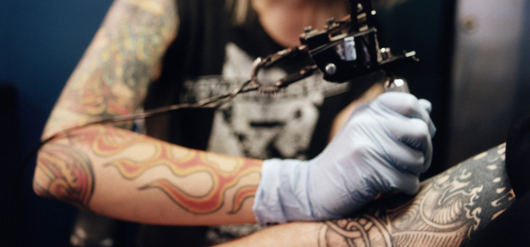Skin penetration

Certain procedures such as waxing, acupuncture and body piercing are of a higher risk to both the public and to practitioners. Operators conducting these procedures need to be aware of the risks and the appropriate practices to minimise this risk.
The definition of skin penetration includes:
- acupuncture
- beauty treatments including waxing and electrolysis
- body, nose and ear piercing
- cosmetic enhancements
- colonic lavage
- tattooing
- blood cholesterol and glucose measurement
Frequently Asked Questions
Cleaning is the process of physically removing any dirt and residue from equipment and surfaces by washing with warm water and detergent. This must be undertaken on all equipment and surfaces.
Disinfection is the process of killing micro-organisms that may cause disease; this can be achieved through either thermal or chemical methods and must be carried out on all surfaces and equipment that people may come in contact with.
Sterilisation is the total eradication of all micro-organisms including bacterial spores. This can be achieved by either using sterilised single-use items or using an approved autoclave prior to each use.
Unhygienic skin penetration practices and procedures may affect the health of both the client and the operator. Unhygienic skin penetration procedures have the potential to transmit bacterial and fungal infections, as well as viral infections such as HIV, Hepatitis B and Hepatitis C.
Hands should be washed before and after attending to each client, cuts and abrasions should be covered with a waterproof dressing and be changed as necessary when soiled. Sterile disposable gloves should be used at all times when there is contact with a client and a new pair should be worn for each individual client. All equipment should be cleaned, disinfected or sterilised depending on its usage. Before commencing a skin penetration procedure, skin should be wiped with a suitable antiseptic and allowed to air dry.
Skin penetration businesses produce waste that is classified as 'hazardous waste' under the Protection of the Environment Operations Act 1997. This includes sharps waste (needles, blades, lances) and clinical waste (single use equipment soiled with blood). Sharps should be placed into a yellow Australian Standards approved sharps container that is puncture resistant, waterproof and leak proof. Clinical waste and sealed sharps containers must be collected and disposed of through a licensed contractor.
Disposal of sharps into the general waste stream is dangerous and highly illegal.
Register a skin penetration premises or change your details
Find out more about the Department of Health requirements for skin penetration
Report concerns about a skin penetration premises in Hornsby Shire
Require further information?
If you would like further information on skin penetration please contact Council's Health Team on (02) 9847 6666.







